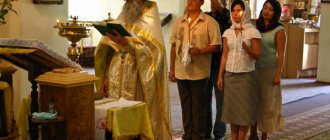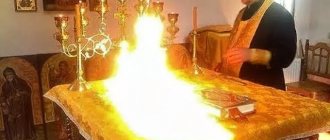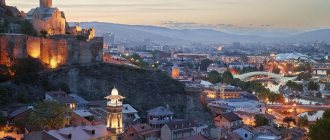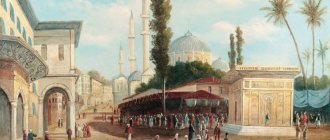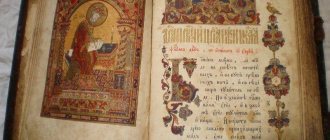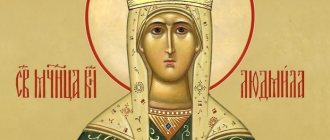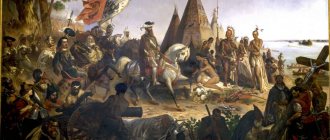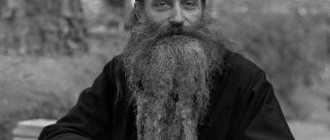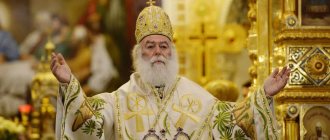North Ossetia is preparing to celebrate the 1100th anniversary of the baptism of Alania on a large scale. Festive events are scheduled for 2022, but preparations for the important religious date are already underway. The decree on celebrating the anniversary of the baptism of Alanya was previously signed by Russian President Vladimir Putin. How North Ossetia turned out to be one Orthodox republic among Muslim regions and how Christians live - in the material of MIR 24 correspondents.
Now the churches of North Ossetia look more like a construction site. Inside the Cathedral of St. George, the main temple of the republic, there are scaffoldings. The vault is being painted. The church, built several decades ago, has not yet been decorated.
The artists’ work is also taking place in the highest mountain monastery in Russia – the Alan Dormition Monastery. Despite the scaffolding, it was here, at an altitude of almost two thousand meters above sea level, that the main Easter service was held.
North Ossetia-Alania was baptized in 916 and 1754
The great baptism of Alania (as North Ossetia was called in ancient times) took place in 916. It was then that Patriarch Nicholas the Mystic of Constantinople established the Alan diocese.
Three Alan temples dating back to the 9th - 10th centuries have survived to this day. These are the oldest Christian churches located in Russia. It should be noted that Christianity brought writing to the Ossetian land.
Northern Zelenchuk Temple of the 10th century. The oldest Christian churches in Russia are located on the territory of Ossetia
In the 4th quarter of the 13th century, the Zikh and Alan metropolises united, which led to the departure of Christians to the Sarai metropolis.
After Byzantium fell and the Alanian state collapsed as a result of raids by nomads, its population was almost completely destroyed by barbarians. As a result, Christianity regressed to a folk custom.
1745
this year Ossetia was baptized for the second time
The population of Ancient Alanya consisted not only of Christians, but also Muslims.
In the spring of 1745, headed by Archimandrite Pachomius, the Ossetian Russian Orthodox Ecclesiastical Commission arrived in Ossetia. As a result, Ossetia was baptized a second time.
The new baptism must be viewed as an act of political loyalty to Russia.
Ancient Beliefs
Belief in God (the creator of this world), in the existence of the soul, patron spirits and the afterlife are closely intertwined with the cultural customs of the representatives of the ethnic group. Many Ossetian rituals and customs have religious roots.
Folk religion has been influenced from outside for many centuries, changing and merging with introduced elements of other practices.
Paganism
The ancestors of the Ossetians left no temples, no idols, no books, or other religious shrines. The basis of the ancient belief is the unification of man with nature. Therefore, it was customary to spend all holidays in the open air (in the forest, in the mountains, near the river).
In the ideas of the ancient Ossetians, there was no need for religious leaders. Instead, the people revered the elders, who passed on wisdom and traditions to the young.
The religion of the Ossetians was based on the recognition of one God, but they still made sacrifices to patron spirits.
They believed that God was more than just a fulfiller of people's requests. And the spirit is an integral part of nature, which can be used for your benefit if you know how to do it.
All religious holidays were joint feasts. People of different classes gathered at a common table. Conversations about spirits, mythical ancestors and social problems and affairs took place over traditional dishes.
Interestingly, the Ossetian pies known to many have religious significance. Three pies are served on the table on family and religious holidays and prayers are said in a certain sequence.
Orthodox traditions
Ossetia became acquainted with the Orthodox religion a very long time ago.
In 2014, the Orthodox world celebrated the 1100th anniversary of the baptism of Alanya. According to the official version of the Alan Diocese of North Ossetia, in the 10th century, Bishop Peter from Constantinople (Byzantium) baptized the Alan people.
On the other hand, many historians believe that the first acquaintance with Christianity was much earlier. They learned about the teaching on the territory of the Sarmatians and Scythians from the apostles Andrew the First-Created and Simon the Canaanite back in the 1st century AD. e. Their sermons were received with enthusiasm, because they did not run counter to popular beliefs and cultural values of the population. On this fertile soil the Scythian (Tomitan) diocese was formed, and in Tauro-Scythia there were already five of them. Even before 451, twelve Alan (Scythian) bishops were known.
A new wave of Orthodox preachers in Ossetia appeared in the 8th century. Then the Orthodox Synod of Russia set tasks for the missionaries, which included both strengthening Orthodoxy and establishing political ties between states.
For a long time Ossetia belonged to the jurisdiction of the Astrakhan diocese
From 1602 to 1829, the North Caucasus, including Ossetia, in church and administrative terms, was part of the Astrakhan diocese.
At the same time, Christianity began to spread among the Caucasian peoples only after the formation in 1745 of the Ossetian Spiritual Commission, which worked in Kizlyar and Mozdok.
Bishop Gaius (Georgiy Takaov). The bishop headed the Mozdok vicarage of the Astrakhan diocese in 1793-1799
From 1793 to 1799, the Mozdok Vicariate of the Astrakhan Diocese operated under the direction of Bishop Gaiya (Takova).
He was instructed to fulfill all the duties assigned to the Spiritual Ossetian Commission and transferred to everyone the existing and under construction temples and monasteries in Mozdok, Kizlyar and Ossetia itself.
In 1811, the Georgian Exarchate of the Russian Orthodox Church was established. In addition, another four years later, the Ossetian Spiritual Commission began its activities in Tiflis.
She conducted missionary activities in the territory of North and South Ossetia, as well as in the territory of Abkhazia and Dagestan.
In 1817, she was subordinated directly to the Exarch of Georgia.
In 1836, a school for Ossetian children was opened in Vladikavkaz, which prepared them to work as priests of Ossetian parishes, as well as as missionaries or preachers.
Revered deities of the people
The folk religion of Ossetians is monotheistic. God is called Khutsau. He is the only creator of the world. And he controls everything, including the spirits, to whom, according to tradition, one should direct one’s requests.
Here are some of the revered patrons of the people:
- Wacilla is the spirit of thunder and light. It was originally known as Thunderer, but with early Christianity it was changed to Wacillus, which is the name of the biblical prophet Elijah. If a person was killed by thunder, it was believed that he had angered Huacillus.
- Uastirdzhi - sometimes called Saint George
- . He is the patron of husbands, travelers, young and old, the scourge of thieves and murderers. He is the most famous and most respected spirit of the Ossetian people in both North and South Ossetia.
- Tutir is the patron and ruler of wolves.
- Falwara is the protector of livestock. He is considered the kindest and most peaceful spirit.
- Afsati is the ruler of wild animals and the patron of poor hunters. He is usually depicted as an old man with a long white beard, sitting on a high mountain. In the old days, hunters would take three pies with them to offer to Afsati for good luck.
- Barastyr is the patron saint of dead people and the afterlife. He cares for people in both hell and heaven.
- Don Bettir is the ruler of the water, who lives in the water and owns fish. He is the patron saint of fishermen.
- Rynibardug is the spirit of disease.
- Madi Mairam is the patroness of women who is closely associated with St. Mary of the Christian religion.
- Sau Dzuar is the patron of the forest, who protects it from fire.
- Safa is the creator and patron of the nadochna chain, especially revered in connection with the value of the home for the family.
Of course, this is not a complete list. But it shows what role spirits and saints played in people's lives. Legends were told about spirits and patrons, sacrifices were made to them, they tried to appease them with rituals and holidays, special places were dedicated to them and sanctuaries were made. Ossetian mythology is permeated with exciting stories about the amazing life of the patrons of the people.
In the 19th century, all Ossetian parishes were united
In the 40s of the 18th century, the military situation in the Caucasus worsened and therefore it was necessary to raise the work of the Spiritual Mission in Ossetia to a high level.
That is why in 1856 the Exarch of Georgia united the parishes of North Ossetia under the leadership of the senior dean; he also became a missionary. In addition, in 1860, the Society for the Restoration of Orthodox Christianity in the Caucasus was established.
Badge of the Society for the Restoration of Orthodox Christianity in the Caucasus, IV degree. The society set as its goal the fight against sectarianism and paganism in the Caucasus
Joseph was appointed archimandrite and initially his residence was the village of Alagair, and in 1861 - 1869 Vladikavkaz.
The archimandrite was actively involved in education, preached in the Ossetian language, compiled the Ossetian alphabet for parish schools, and began work on a Russian-Ossetian dictionary. Thanks to his efforts, the Vladikavkaz Ossetian girls' school was founded in 1863.
Archimandrite Joseph actively preached in the Ossetian language.
On April 3, 1875, Emperor Alexander II issued a decree establishing the Vladikavkaz vicarage. Its jurisdiction extended to churches and clergy in the city of Vladikavkaz and the Alagir plant.
Archimandrite Joseph (Chepigovsky) became the bishop of Vladikavkaz. In the first years of its existence, the Vladikavkaz Vicariate included 20 parishes (by 1881 - 24 parishes); more than 30 Orthodox schools operated in Ossetia.
Military-Ossetian road. Alagir. Silver-lead plant. 1866 The Vladikavkaz vicarage, established in 1785, extended its jurisdiction to the Alagir plant
In 1885, the Vladikavkaz vicarage was transformed into the Vladikavkaz diocese. This happened as a result of the reorganization of the Caucasian and Ekaterindar diocese.
Stavropol was appointed its center. At the same time, the Terek region was removed from the diocese, including its composition in the newly formed Vladikavkaz diocese.
His Grace Joseph (Chepigovsky), nicknamed “Apostle of Ossetia”
The Vladikavkaz and Mozdok diocese existed from 1885 to 1922. On September 10, 1894, she was removed from the subordination of the Exarch of Georgia.
It must be remembered that initially the Terek region was included in the territory of the diocese. Later, the Dagestan region and the Ossetian village of Novogeorgievskoye, Kuban region, were annexed to it.
Vladikavkaz. Cathedral of the Archangel Michael. From 1863 to 1893 he was part of the Vladikavkaz department
At the beginning of the twentieth century. the territory of the diocese included modern North Ossetia, Kabardino-Balkaria, Dagestan, Chechnya, Ingushetia and the Caucasian Mineral Waters region.
Cathedral city - Vladikavkaz. Cathedrals - Vladikavkaz Spaso-Preobrazhensky (1863-1893) and Michael-Arkhangelsk (since 1894), Uspensky in Mozdok (since 1894).
In 1910-1914. The Pyatigorsk Vicariate existed as part of the Vladikavkaz diocese.
His Grace Joseph (Chepigovsky) was nicknamed “the apostle of Ossetia.”
Orthodox Ossetia especially remembers the activities of His Grace Joseph (Chepigovsky) for his spiritual exploits. At the same time, he worked in difficult conditions, because the Ossetian mountain parishes were small and poor.
In addition, a feature of the Vladikavkaz diocese was that the number of Orthodox Christians living on its territory (about 300 thousand people in the early 90s of the 19th century) was less than the number of Muslims (about 400 thousand people) , as well as sectarians and Old Believers (the latter lived, in particular, in the Kizlyar department, the village of Chervlennaya, Essentuki).
Bishop Joseph translated the Holy Scriptures and church texts into the Ossetian language. He contributed a lot to the development of education in Ossetian.
Through his efforts, books in the Ossetian language were published in Vladikavkaz starting in 1881. Among them are: “Primer”, “Sacred History”, multi-volume “Russian-Ossetian Dictionary with Brief Grammar”, etc.
136 temples
numbered in the diocese by 1889
By 1889, Bishop Joseph, at his own request, was retired. At that time, there were 136 churches in the diocese. Orthodox Ossetians still remember the “Ossetian Apostle” with kind words.
Specifics of Ossetian beliefs
Ossetians, Muslims or Christians, those who profess traditional religion or other movements, they all remain one united people, tolerant of other cultures and at the same time committed to their ancient values.
God is one for everyone—that’s what the ancients thought, that’s what the elders teach. And to this day, the Ossetian people are very tolerant of a variety of religions.
The culture of the Ossetian people has evolved over centuries. Its unique features are largely determined by religious motives.
Primitive religion formed among the ethnic group respect for women, veneration for the older generation, attentive attitude to nature, hospitality, etc.
These principles were reinforced by Islam, which also influenced the formation of management principles, the desire for self-education and self-improvement.
The influence of Christianity made its own adjustments to the life of the people through rituals and adjustments to the holiday calendar.
Various religions that came to the land of the Irons left their contributions to the development of art.
It is difficult to distinguish between the influence of individual religions on specific aspects of Ossetian culture. However, we can confidently say that the culture and religion of this people go hand in hand and complement each other.
From 1900 to 1913, the Vladikavkaz and Mozdok diocese actively developed
In 1894, the Vladikavkaz and Mozdok diocese separated from the Georgian Exarchate. This happened thanks to the activities of Bishop Vladimir (Sinkovsky), transferred from the Altai spiritual mission.
As a result, the boundaries of the diocese expanded, and a spiritual consistory began to operate under it. In 1895, the Vladikavkaz diocese was divided into 13 deanery districts.
Archbishop Vladimir. 5th Bishop of Vladikavkaz and Mozdok. Thanks to his missionary activities, the Vladikavkaz and Mozdok diocese separated from the Georgian Exarchate
Through his efforts, the Ardon Ossetian Theological School was transformed into the Alexander Theological Seminary.
At the same time, the bishop also in 1895 established at the seminary a department of the diocesan school council for the management of parochial schools in North Ossetia.
On January 1, 1895, the first issue of the Diocesan Gazette was published. Books and brochures with religious and moral content were also distributed in the diocese.
In 1902, the Gospel was published in the Ossetian language.
In 1894, through the efforts of Bishop Vladimir, 2,000 fugitive Cossacks joined the Orthodox Church. And in subsequent years, missionary work became the main activity of the diocese.
On September 22, 1910, the Pyatigorsk Vicariate was established to help the Vladikavkaz bishop. Arseny (Smolenets) became its bishop.
On December 22, 1913, Bishop Antonin (Granovsky), later a famous figure in renovationism, was appointed to the Vladikavkaz See. At this time, a massive transition of Orthodox Christians to Baptists and other sects began in the diocese.
Bishop Antonin (Granovsky) 9th Bishop of Vladikavkaz and Mozdok. A prominent figure in the schism and renovationism. Under him, a massive transition of Orthodox Christians to Baptists and other sects began in the diocese.
The Vladikavkaz clergy recognized the Provisional Government and the Whites, but did not recognize the Reds
During the revolutionary events of 1917, the Vladikavkaz clergy accepted the Provisional Government. It did not recognize Soviet power.
When Vladikavkaz was taken by Denikin’s army in 1919, representatives of the diocese welcomed it. When Soviet power was established and consolidated in the North Caucasus in 1920, Bishop Macarius fell under a revolutionary tribunal, the diocesan council was dissolved, and the confiscation of church valuables began.
Bishop Macarius (Pavlov). 10th Bishop of Vladikavkaz and Mozdok. After Vladikavkaz was occupied by the Reds in 1922, he deviated into renovationism and began to be called “Pyatigorsk”
At the end of August 1922, Bishop Macarius deviated into renovationism and therefore began to be called “Pyatigorsk”. Most of the clergy followed him.
In 1943, all Orthodox parishes of the former Terek and Dagestan regions became part of the Stavropol diocese.
March 22, 2011
The Vladikavkaz and Alan diocese has been restored
Since the mid-20th century, the Stavropol and Baku diocese has operated on the territory of North Ossetia, and the Stavropol and Vladikavkaz diocese has operated since 1991.
The Vladikavkaz and Alan diocese was restored on March 22, 2011. It included parishes and monasteries in the republics: North Ossetia - Alania, Dagestan, Ingushetia, Chechnya.
In addition, Orthodox Christians from South Ossetia are also spiritually nourished here.
No. 37 (646) / September 26 '11
Diocese
of Ekaterinburg, September 26, “Information Agency of the Ekaterinburg Diocese.”
Archbishop of Vladikavkaz and Makhachkala Zosima
Date of birth: July 12, 1950 Date of ordination: December 24, 1995 Date of tonsure: August 21, 1987 Angel Day: August 21
- Born in the village. Novocherkassk, Tselinograd region of Kazakhstan, in a family of employees, in 1964 he became an orphan.
- In 1968 he graduated from a boarding school.
- In 1968-1970 served in the Soviet army. Then he entered the Moscow Theological Schools. Appointed as a full-time psalmist in the church in honor of the Dormition of the Mother of God in Makhachkala.
- On December 13, 1981, Bishop Anthony of Stavropol and Baku ordained him a deacon, and on December 27, he was ordained a presbyter and appointed full-time priest of the Church of the Archangel Michael in Grozny.
- In 1984, he was appointed to the Holy Cross Church in the village of Priyutnoye in Kalmykia.
- In February 1985, he was appointed rector of the Holy Cross Church in Elista.
- On August 21, 1987, he was tonsured a monk with the name Zosima. He was elevated to the rank of abbot and appointed dean of Orthodox parishes in Kalmykia. He was a member of the Diocesan Council.
- On October 6, 1995 he was elevated to the rank of archimandrite. On the same day he was elected Bishop of Elista and Kalmykia.
- On December 23, 1995, the naming of Archimandrite Zosima took place at the Epiphany Cathedral in Moscow. On December 24, 1995, in the Epiphany Cathedral, he was consecrated Bishop of Elista and Kalmykia.
- On February 24, 2006 he was elevated to the rank of archbishop.
- By the decision of the Holy Synod of March 22, 2011 (journal No. 13), he was appointed to the Vladikavkaz and Makhachkala departments.
Awards
- church: - Order of St. Sergius of Radonezh II degree; - Order of St. Blgv. Book Daniil of Moscow II degree; – cross Ap. Paul of the Greek Orthodox Church.
- secular: - State Order of Friendship.
Brief information
- Date of creation: March 22, 2011. Formed by the decision of the Holy Synod of March 22, 2011 (magazine No. 13). The diocese includes parishes of the republics of North Ossetia - Alania, Dagestan, Ingushetia and Chechnya. There are 45 operating churches, including: parish churches – 42, affiliated churches – 3; churches under construction – 17; chapels – 15.
- Address: 362008, Republic of North Ossetia - Alania, Vladikavkaz, st. Dzerzhinsky, 70, parish of the Church of the Prophet Elijah.
- Telephone:
- Fax machine:
- Email:
Monasteries
- Uspensky Alan male: Republic of North Ossetia - Alania, Alagirsky district, village. Fiagdon, Hidicus, 30; tel.: (86731) 5-12-44.
- Epiphany Alansky Women's: 363246, Republic of North Ossetia - Alania, Alagir, st. Kirova, 185; tel: (86731) 3-22-70.
- Women's Holy Cross: Republic of Dagestan, Kizlyar, st. Radishcheva, 17.
Educational establishments
- Vladikavkaz Orthodox Theological School: Republic of North Ossetia - Alania, Vladikavkaz, st. August Events, 83, Holy Protection Church;
- Vladikavkaz Orthodox Gymnasium named after. A. Kolieva: Republic of North Ossetia - Alania, Vladikavkaz, st. Barbashova, 38, St. George's Cathedral.
Diocesan media
- website "Orthodox Ossetia";
- “Orthodox Ossetia” (monthly newspaper).
Orthodoxy in the North Caucasus
Its history began long before the Baptism of Rus'. The ethnic and political boundaries of the North Caucasus have changed more than once, but the lamp of the Orthodox faith has not gone out here since the time of the apostles.
In the 1st century AD, when the apostles dispersed to different ends of the earth with the Good News, the Caucasus was an arena of rivalry between Rome and Parthia. Of course, the influence of empires extended mainly to Transcaucasia, but the lands north of the Caucasus Mountains did not remain aloof from the events of world history. According to Tradition, the apostles Andrew the First-Called and Simon the Canaanite could come to the Caucasus from the Black Sea, and Bartholomew from the Caspian Sea. There is a legend that the Apostle Bartholomew met martyrdom in the vicinity of the now Dagestan city of Derbent. In the 4th century, Christianity took root in Georgia, Armenia and Caucasian Albania (a state in the territory of modern Azerbaijan). At the same time, the first, semi-legendary information about the monasteries in Alanya appeared. An important milestone in the history of Christianity in the North Caucasus was the mission of the Byzantine emperor Justinian on the Black Sea coast in the middle of the 6th century among the Abkhaz-Adyghe peoples. Apparently, then the network of Orthodox dioceses subordinate to Constantinople covered territories from the sea to present-day North Ossetia.
In the 7th century, the Byzantines retreated from the Caucasus under the blows of Zoroastrian Persia. The destructive war between Emperor Heraclius and Shah Khosrow devastated the lands from the Black Sea to the Persian Gulf, and soon a third force reigned in the depopulated lands - Islam. During these years, the North Caucasian dioceses were temporarily resubordinated to the Patriarch of Georgia. In the 10th century, the Alan Metropolis, formally subordinate to Constantinople, emerged, one way or another caring for the peoples from the Black Sea to the Caspian Sea. Its center, according to archaeologists, was located in the valley of the Zelenchuk River in present-day Karachay-Cherkessia. In the X-XI centuries, most of the modern peoples of the North Caucasus, from the Circassians to the Dagestanis, were baptized... The so-called “Great Baptism of the Alans” dates back to 916. But at the same time, Islam began to spread from the south, and Muslim Turks settled in Azerbaijan.
The Alanian state was crushed by the Mongol hordes in the 13th century. In the 14th century, the invasion of Tamerlane swept through the foothills. Civilization fell into decay, and not even ruins remained of many flourishing cities. Alans (ancestors of Ossetians) and Adygs (ancestors of Adygeis, Kabardians and Circassians) leave the plains for the mountains, some Alans move to Transcaucasia. Part of the Polovtsian nomadic tribes, the future Karachais and Balkars, also retreat to the foothills. Dagestan suffered the most, where hordes of nomads constantly passed through the Derbent Gate. There, Orthodoxy gave way to Islam already in the 14th-15th centuries.
A problem is arising in the North Caucasus that will weigh heavily on local Christianity for many centuries to come. The fact is that the Christian church is very vulnerable. The sacraments, including the most important of them, the Eucharist, can only be performed by a priest. A priest can be ordained only by a bishop, and a bishop by other bishops who trace their succession to Christ and the apostles. Therefore, the physical destruction or geographical removal of the episcopate leaves the people without shepherds. When wars engulfed the Caucasus and previous ties were severed, Christianity began to slowly fade away. At this time, Catholics are trying to take advantage of the situation - Franciscan missionaries are sent from the Genoese colonies of Crimea. Despite the eventual failure of this mission, they played an important role in supporting the fading faith.
Still, in Ossetia and partly in Kabarda - the most developed principalities of the North Caucasus - Orthodoxy managed to survive dark times. Many clans of Adygea, Circassia and Chechnya also remained Orthodox. And from the beginning of the 16th century, the first contacts with Russia were established. In 1561, Russian Tsar Ivan the Terrible married the Kabardian princess Maria Kuchenei. The monument to Maria Kabardinskaya still adorns the central square of Nalchik. However, apparently, before arriving in Russia, Mary was a pagan, and received Baptism in Moscow.
In 1602, the Astrakhan diocese was founded, which included the lands of the peoples of the Caucasus friendly to Russia. However, the further advance of the Russians was stopped for a long time by wars with the Crimean Khanate and Turkey (in the west) and with Persia (in the east). In the 17th century, widespread penetration of Islam into the Caucasus began.
In 1744, the Synod of the Russian Orthodox Church, due to the impossibility of permanently caring for Kabarda and Ossetia, decided to temporarily transfer these lands under the omophorion of the Georgian Church. In 1759, the Orthodox Kabardians exodus to the northeast, they accepted Russian citizenship and founded the city of Mozdok (now in North Ossetia). In 1774, according to a peace treaty with Turkey, all of Ossetia and Kabarda finally became part of Russia.
Russia established itself in the North Caucasus, and soon began moving south from the Caucasus Range. But the Circassians in the west and the Chechens in the east resisted the centralization policy. The Caucasian War began, in the first stage of which the Chechen Sheikh Mansur, predecessor of the famous Shamil, played an important role. He declared a holy war on Russia - jihad, and many dissatisfied with Russia, but religiously wavering leaders of Chechnya, Kabarda and Adygea converted to Islam. In the fight against the pro-Turkish Muslims of Sheikh Mansur, the government of Empress Catherine decided to rely on the Muslims of the Volga region loyal to St. Petersburg. This policy continued under her successors.
In 1840, the secretary of the Kabardian Provisional Court asked the commander of the Russian troops, General Grabbe, to send “enlightened and well-intentioned mullahs” to the Caucasus, mainly natives of Kazan and Bukhara, “so that on the spot and openly in mosques they could convict Shamil and his followers of a false interpretation of the Alkoran.” Muslim spiritual administrations began to be created. At the end of the 17th - beginning of the 19th centuries, Christianity completely disappeared in Chechnya, only Ossetia and partly Kabarda remained Orthodox.
In 1880, with the assistance of the Holy Synod, the Society for the Restoration of Orthodox Christianity in the North Caucasus was founded. In 1885, the Vladikavkaz diocese was organized (until 1894, it was part of the Georgian Exarchate).
When the Russian Empire collapsed, attempts were made to organize a Mountain Republic in the North Caucasus (1917-1918). The flag of the Mountain Republic, elements of which can now be seen on the state flag of Abkhazia, consisted of alternating three white and four green stripes. Three white stripes are Orthodox Abkhazia, Kabarda and Ossetia, and four green stripes are Muslim Adygea, Karachay-Balkaria, Chechnya and Dagestan. As we see, a hundred years ago, although the majority of Kabardians at that time professed Islam, the separatist mountaineers themselves perceived Kabarda as a country of the Orthodox tradition.
Now, with the exception of Ossetia, Orthodoxy in the Russian republics of the North Caucasus remains predominantly the religion of the Russian minority. However, growing interest in the history of their ancestors may push those North Caucasians who have not yet chosen their faith to new spiritual quests.
Vladikavkaz Theological School
In 1887, on the initiative of His Grace Bishop Vladimir (Senkovsky) of Vladikavkaz, the theological school was transferred from Mozdok to Vladikavkaz. This school was founded in Mozdok in 1834 and for a long time served not only as a conductor of Orthodoxy in the region, but also as one of the main centers of culture and the spread of literacy among the local population.
Since by this time Mozdok had already lost its former status as an important administrative center on the Terek, and Vladikavkaz was increasingly becoming the main city in the Terek region, there was a need to transfer the religious school here.
For the needs of the school, a building was purchased for 2 thousand rubles that belonged to Enikalov (corner of Vorontsovskaya and Georgievskaya streets, now Butyrin and Borodinskaya), a former adjutant to the head of the Terek region, General M.T. Loris-Melikova. This house was built by Persian builders in 1871.
In Vladikavkaz, the school was located in Mamulov’s house on Vrevskaya Street (now Armenian) since, according to the contract, the regional administration was located in Enikalov’s house. In addition, the building was too small for a school. Therefore, construction of a new building began next to it.
In 1895, a new building was erected. It housed classrooms, a hall, a dining room, a library, an office, a teacher's room and apartments for three teachers, and in the old building there were bedrooms and apartments for the caretaker and assistant. The school building also housed the home church of St. Cyril and Methodius.
On January 1, 1896, the Vladikavkaz Theological School moved to new premises, moving from Mamulov’s house. Its grand opening took place on January 13.
The Vladikavkaz Theological School was a lower educational institution for primary education and preparation of children for serving the Orthodox Church. It consisted of four classes with a one-year course of study in each and one preparatory class. The school accepted children of all classes of the Orthodox confession, and children of the clergy were enrolled free of charge, and everyone else paid 35 rubles a year. The first grade included children from 10 to 12 years old who knew the Creed, the commandments, the first two operations of arithmetic, and the multiplication table.
Those who successfully completed the full course of the school were transferred to the theological seminary without exams. And upon entering the civil service, they had the right to promotion to the first class rank without testing.
Most of the children of the clergy of the Vladikavkaz diocese studied here: Mikhail Nakusov, Evgraf, Vladimir and Alexander Tsereteli, Alexander Tokaev, Georgy Agladze, Yakov and Sergey Babievs, Alexander and Mikhail Orlinsky, Alexander Bogoyavlensky, Valentin Kosmiadi, Mikhail and Nikolai Gadievs, Pyotr Kardashevsky and many other. Not all of them later became priests. For example, Mikhail (Tsomak) Gadiev is a famous poet, statesman and scientist, Pyotr Kardashevsky and Sergei Babievs became officers, someone chose the profession of a teacher.
During Soviet times, the school was closed.
On October 6, 2010, at a meeting of the Holy Synod of the Russian Orthodox Church, a decision was made to open a theological school in the Republic of North Ossetia-Alania with the aim of accelerating the training of Ossetian church and clergy for further service in Ossetian-speaking parishes.
Epiphany Alan Convent
On March 18, 2004, by the Decree of His Eminence Theophan, the then Bishop of Stavropol and Vladikavkaz, the Orthodox sisterhood of the Holy Dormition Skete in the city of Alagir, Republic of North Ossetia-Alania, was transformed into the Epiphany Alan Convent.
At the request of Bishop Feofan, the government of the Republic of North Ossetia - Alania and the Republican Trade Union Committee transferred 15 hectares of land and dilapidated premises of the former Voskhod pioneer camp to the monastery.
By the determination of the Holy Synod of December 29, 2004, the elder sister of the Epiphany Alan Monastery, nun Nonna (Bagaeva), was appointed abbess, with the laying of a pectoral cross according to her position. Mother Nonna took monastic vows in 2002. She was tonsured by Abbot Anthony (Danilov), the abbot of the Holy Dormition Alan Monastery. While in the world, Natalya Bagaeva graduated from the history department of SOGU, the directing department of the IPK TV and RV. While working as a director at the Alania State Television and Radio Broadcasting Company, she simultaneously entered graduate school at the same institute in the department of art history. One of her reports, namely a report about Elder Hippolytus, the abbot of the St. Nicholas Monastery in the city of Rylsk, completely changed her life. In 2011, she was elevated to the rank of abbess and was presented with the abbot's staff. She was elevated to the rank of abbess by Archbishop Zosima of Vladikavkaz and Makhachkala.
Since the creation of the monastery, the number of sisters has tripled. Thanks to the efforts and aspirations of Bishop Theophan, the new monastery was rebuilt at an unprecedented pace - within a year, a temple, a building for pilgrims, a separate building for monastic workshops were built in the monastery, the sister building was partially restored, gas, electricity, and telephone were installed in the territory, but much remains to be done.
From the first day the monastery was called to serve people. Therefore, in the spring of 2005, a rehabilitation center was organized in the monastery for children who suffered in Beslan.
On the territory of the monastery a temple was built, consecrated in honor of the Venerable Martyrs Grand Duchess Elizabeth and Nun Varvara.
Dormition Alan Monastery
An Orthodox monastery near the village of Verkhniy Fiagdon in the Kurtatinsky Gorge (Alagirsky district of North Ossetia).
The monastery was created in April 2000 in a former hotel for train drivers (Beslan is a large railway junction on the Rostov-Baku line). In the first year there were only two monks in the monastery. The monks underwent spiritual training in the Kursk diocese, in the St. Nicholas Monastery under Archimandrite Hippolytus.
Over time, the monastery moved to the Kurtatinskoye Gorge, where a 19th-century temple was restored and a new, more spacious one was being built. A monastery courtyard remains in Beslan.
There has been a large increase in visits to the monastery by believers in Ossetia and the surrounding regions.
Church of the Nativity of the Blessed Virgin Mary in Vladikavkaz
The Church of the Nativity of the Blessed Virgin Mary on Ossetian Hill is the oldest Orthodox church in Vladikavkaz. It was founded in 1815 by the Ossetian Spiritual Consistory, and for more than 50 years all Orthodox residents of the Vladikavkaz fortress were its parishioners. In 1823, instead of a wooden church building, a stone one was built and consecrated on March 24, 1824. The church is the only surviving building located on the territory of the fortress.
The Church of the Nativity of the Blessed Virgin Mary almost suffered the fate of many churches and monasteries. In 1929, they decided to destroy the temple, but the parishioners, the rector and the clergy stood up on the defensive. It was not possible to destroy the church, and the attempts to destroy it stopped for two years, but in 1931 they resumed again. As a result, in 1931 the temple was closed and transferred to the city executive committee. From 1940 to 1993 it was a literary museum named after. K. L. Khetagurova.
When the church was handed over to believers in 1993, large-scale restoration began. Nowadays the temple is operational and services are held regularly. The revered shrine of the temple is the Mozdok Icon of the Mother of God. In the necropolis around the church are the graves of prominent residents of Vladikavkaz and North Ossetia, including Kosta Khetagurova, Gappo Baev, Vaso Abaev.
Temple of the Archangel Michael in Grozny
Church of the Archangel Michael in Grozny (common names - Archangel Church, Michael the Archangel Church, St. Michael's Church) is an Orthodox church located in the city of Grozny, Chechnya.
The temple was founded at the end of the 19th century by Terek Cossacks. Before the start of the first Chechen war, it was one of two operating Orthodox churches in the Chechen-Ingush Autonomous Soviet Socialist Republic.
During the Chechen conflict, the temple was destroyed in 1995. The restoration of the Archangel Michael Church began actively at the end of 2004; opened in 2006, consecration took place in 2009.
© When using information, a link to the media “Information Agency of the Ekaterinburg Diocese” (registration certificate IA No. 11-1492 dated May 29, 2003) is MANDATORY.
In other rooms:
North Ossetia in our time is one of the centers of Orthodoxy in the Caucasus
North Ossetia and the Vladikavkaz and Alan diocese itself is one of the recognized centers of Orthodoxy in the Caucasus. Currently, the diocese has about 50 chapels and churches, three monasteries, spiritual educational and children's rehabilitation centers.
Orthodox gymnasium named after Akso Koliev, located on the territory of St. George's Cathedral in Vladikavkaz. This is the first and only Orthodox gymnasium in the diocese that gives students the opportunity to receive an education in accordance with state educational standards
In addition, the Orthodox gymnasium named after Akso Koliev operates in the diocese. It was opened on November 16, 2005.
This is the first and only Orthodox gymnasium in the republic, which provides students with the opportunity to receive education in accordance with state educational standards.
The national dance ensemble “Arv”, the choir “Blagovest”, and the design and research society of students “Kladez” work under it.
Places of power
Over the past 20 years, two new monasteries have appeared in North Ossetia - the Alansky Assumption Monastery in the village of Khidikus and the Alansky Epiphany Monastery in Alagir. The inhabitants moved here from Beslan. The construction of new hermit parishes was blessed by an elder from the Rila Monastery. His instructions turned out to be correct. The monasteries became the spiritual centers of Christianity in North Ossetia.
An abandoned boarding house was allocated for the convent not far from one of the regional centers of North Ossetia - the city of Alagir. Over the course of 15 years, instead of mountains of garbage and destroyed buildings, a temple, a hotel, a monastery workshop, a refectory and a rehabilitation center for children injured in terrorist attacks appeared. The former TV director, Mother Nonna, became the abbess of the monastery. Every year thousands of believers are baptized in the waters of the monastery lake.
On the Feast of the Epiphany of the Lord people also gather at the Assumption Monastery. The ceremony is carried out in the waters of the mountain river Fiagdon. Hundreds of pilgrims from all over the country come here every year to seek blessings from all over the country.
Now there are 12 monks in the men's monastery. And the revival of Christianity in this gorge began with two inhabitants. The place was not chosen by chance. In a chapel not far from the monastery, one of the most valuable Christian relics, the Iveron Icon of the Mother of God, was kept for several centuries. It was presented to believers by the Queen of Georgia Tamara.
After the services, the pilgrims do not leave for a long time. Guests of the monastery are invited to a meal. They are treated to natural products of their own production and tea made from mountain herbs.
Archbishop of Vladikavkaz and Alan Leonid (Gorbachev) - an outstanding Orthodox missionary
The diocese is headed by Archbishop of Vladikavkaz and Makhachkala Leonid (Gorbachev). He was born on October 26, 1968 in Stavropol. He graduated from high school in Krasnodar in 1985.
After that, he worked as a laboratory assistant at the department of aerodynamics and flight dynamics in the military unit 26265. In parallel with his work, he served as a sexton of the St. George Church in Krasnodar.
Archbishop of Vladikavkaz and Alan Leonid (Gorbachev). Currently, Father Leonid leads the diocese. He is known as a missionary and has received ecclesiastical and secular awards.
After serving in the army in 1988 - 1989, he became a reader-singer of the St. George Church in Krasnodar, as well as a subdeacon of Bishop Isidore of Ekaterinodar and Kuban. Then he studied at the Leningrad Theological Seminary. In 1990 he was ordained a deacon.
Archbishop Leonid (Gorbachev) became an archimandrite on April 11, 2010. In the same year he was tonsured a monk and ordained a hieromonk.
From 1990 to 1997, he first served as a full-time clergyman of the Catherine Cathedral in Krasnodar, and later as a clergyman.
After this, Father Leonid became an employee of the Synodal Department for interaction with the Armed Forces and law enforcement agencies in Moscow. In this capacity, he participated in many missionary trips, including to the “hot spots” of the planet.
Awarding Bishop Leonid with the Order of St. Mark the Apostle of the highest degree and a memorial panagia. He was also awarded other ecclesiastical and secular awards.
On April 11, 2010, he was elevated to the rank of archimandrite. On December 4, 2017, he became archbishop. He was Bishop of Argentina and South America, Bishop of the Patriarchal Residence of the St. Daniel Monastery.
He became Bishop of Vladikavkaz and Alan on June 3, 2016, and on July 28, 2016 he was appointed rector of the Cathedral of the Holy Great Martyr and Victorious George in the city of Vladikavkaz. Awarded secular and ecclesiastical orders.
News of the Vladikavkaz and Alan diocese can be found on the diocesan website
The Vladikavkaz and Alan diocese lives an active life. News about it can be found by visiting the official website of the diocese.
Official website of the Vladikavkaz and Alan diocese
Here you can find information about both the history of the diocese and its modern life.
For example, from the latest news we can mention the congratulations of His Holiness Patriarch Kirill of Moscow and All Rus' to Archbishop Leonid on the anniversary of his enthronement.
In addition, in the news section you can also learn about the progress of construction and restoration work in the diocese.
By leaving a comment, you accept the user agreement

